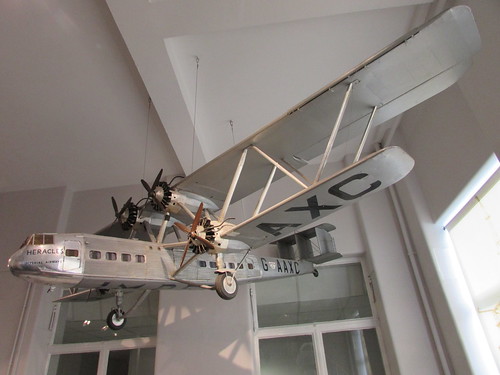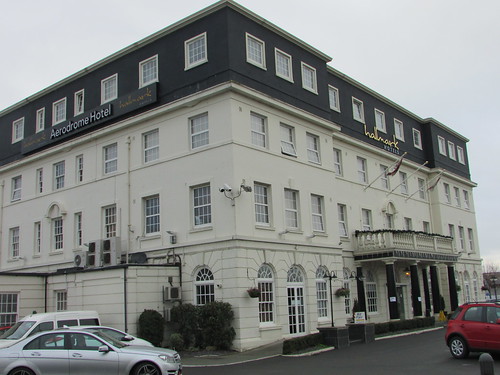
Airport House, Croydon.

A 1:200 scale model of Croydon Airport in its heyday is displayed in Airport House Reception.
The iconic 'big biplane', the Handley Page H.P.42, handled most international flights in and out of Croydon, until replaced by more modern monoplanes like the Armstrong Whitworth 'Ensign'. In the picture above, an H.P.42 is on the left with an 'Ensign' G-ADSR on the right.

An imposing flying model of H.P.42 'Heracles' (G-AAXC) is displayed in the stairwell of Airport House.
History
The Croydon Airport Society website has a concise, but thorough, history here. Croydon Airport Society have also been involved in the creation of detailed published histories (see Related Books, below).
In 1916, the site was used by the fledgling Royal Flying Corps (later the Royal Air Force) as an aerodrome engaged in the defence of London against German airship attacks. The aerodrome replaced Hounslow Heath in 1920 as London's civilian airport and international passenger services were established. The original facilities were rather primitive so an Act of 1925 authorised the building of a new airport with hard-standing near the terminal although the actual runways remained grass.
The new Administration Building, opened 1928, was built by Wilson Lovatt & Son. This construction firm (based in Wolverhampton, where I grew up) was founded in 1914 and survives, although under threat of 'striking off' by the Companies Registrar. A hotel, the 'Aerodrome Hotel', was built adjacent to the Administration building for the convenience of air travellers.

Croydon Airport: Administration Building Ground Floor Plan
(from the Official Guide, 1928).
Click here for a larger view
On the outbreak of World War II in 1939, the airport reverted to military use. In 1946, the airport was restored to commercial use but Heathrow was designated as London's main airport so Croydon's importance diminished although international services and general aviation flying continued until closure in 1959.
Croydon Airport Visitor Centre
Croydon Airport Society was founded in 1978 and in 2000 opened an award-winning volunteer-led micro museum designed by Haley Sharpe Design (whose head office is in Leicester). The first open day in 2017 was Sunday, 8th January 2017 and my friend Rita (who is a member of the Society) and I decided to visit. Adjacent to Airport House the 'Aerodrome Hotel', now operated by Hallmark, survives and retains its original name (but has acquired an additional storey). The Hotel was hosting a one-day sale of aviation memorabilia, including models, books and photographs, which Rita and I checked out. This is an annual event in January, coinciding with the first Open Day of the year by the Croydon Airport Society.

Aerodrome Hotel, Croydon.
Related books
[1] ‘The First Croydon Airport 1915-1928’ (Croydon Airport Society 2001 edition) ISBN 0-9541370-0-0.
[2] ‘Croydon Airport 1928-1939’ by Douglas Cluett, Joanna Nash, Bob Learmonth (London Borough of Sutton Libraries & Arts Services 1980 edition) ISBN 0-9503224-8-2.
[3] ‘Croydon Airport – The Peaceful Years’ by Mike Hooks(2006 reprint) ISBN 0 7524 2758 X (Photographic collection with detailed annotations).
My Pictures
Where necessary, clicking on an image above will display an 'uncropped' view or, alternately, my pictures may be selected, viewed or downloaded, in various sizes, from the album Airport House, Croydon.
